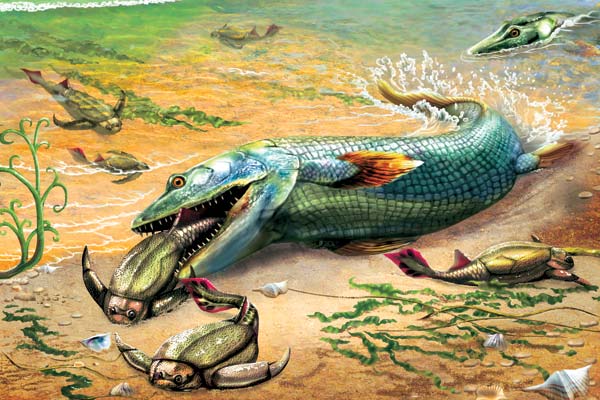 |
 |
 |
 |
 |
Produced
by the Population Genetics and Evolution class, Furman University |
||||
 |
 |
 |
 |
 |
Produced
by the Population Genetics and Evolution class, Furman University |
||||
 |
The
Devonian: Panderichthyes |
 |
||
| Panderichthys
were lobe-finned fish that are considered to be one of the important transitional
links between fish and amphibians (Morton 1997). The first specimens were
excavated from the Frasnian deposits in Latvia (Murphy 2005). There are
two species, P. stolbovi and P. rhombolepis (Murphy
2005). While P. stolbovi is known through only a few snout pieces
and an incomplete lower jaw, P. rhombolepis has a number of complete
specimens (Murphy 2005). This fish ranged in size from 90-130 cm and is
characterized as having a large tetrapod-like head (Wikipedia 2009). The
head of Panderichthys was wide in the back and narrow toward
the snout and had a pair of external nostrils and a choana (hole between
the nasal passage and mouth), which is missing in the all other lobe-finned
fish (Morton 1997). Panderichthys also possessed lungs as well
as gills (Morton 1997), and lacked dorsal and anal fins (Morton 1997).
While these traits, alone, suggest some relationship with terrestrial
tetrapods, the most remarkable characters are the forelimbs. Panderichthys
had pectoral fins that matched the tetrapod forelimb pattern of a humerus,
ulna, and radius; and had a tibia and fibula in the the posterior fins
(Morton 1997). The pelvic girdle also displays derived and ancestral traits,
further supporting that Panderichthys was a transitional genus
(Wikipedia 2009). Finally, Panderichthys possessed the incipient
structure that may have evolved into an inner ear bone found in mammals
(Carey 2006). The spiracle, a small hole located behind the eye which
opens to the mouth, is wider than in other lobe-finned fish and the hyomandibular
bone is much smaller (Carey 2006). This enlarged spiracle may have formed
the ear of land vertebrates. The hyomandibular bone evolved into part
of the reptilian jaw, and then into the stirrup in the inner ear of mammals
(Carey 2006). Page by Chapin Hardy |
 |
| Panderichthys. Photo credit: Vokrugsveta | |
|
Carey B. 2006. Human Ears Evolved from Ancient Fish Gills. LiveScience. Accessed February 22, 2010. Morton GR. 1997. Fish to Amphibian Transition. California State University at Fullerton. Accessed February 22, 2010. Murphy DC. 2005. Panderichthys spp. Devonian Times. Accessed February 22, 2010. Wikipedia. 2009. Panderichthys. Accessed February 22, 2010. |